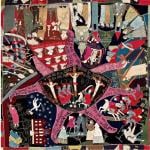HOW AMERICA CAME TO TORTURE ITS PRISONERS:
…They tortured men at military bases and detention centers in Afghanistan and Iraq, in Guantánamo, and in U.S. Navy bases on American soil; they tortured men in secret CIA prisons set up across the globe specifically to terrorize and torture prisoners; they sent many more to countries with notoriously abusive regimes and asked them to do the torturing. At least twice, after the torturers themselves concluded there was no point to further abuse, Washington ordered that the prisoners be tortured some more.
They tortured innocent people. They tortured people who may have been guilty of terrorism-related crimes, but they ruined any chance of prosecuting them because of the torture. They tortured people when the torture had nothing to do with imminent threats: They tortured based on bad information they had extracted from others through torture; they tortured to hide their mistakes and to get confessions; they tortured sometimes just to break people, pure and simple.
And they conspired to cover up their crimes. They did this from the start, by creating secret facilities and secrecy regimes to keep what they were doing from the American people and the world. They did it by suppressing and then destroying evidence, including videotapes of the torture. They did it by denying detainees legal process because, as the CIA’s Inspector General put it in a 2004 report [pdf], when you torture someone you create an “Endgame” problem: You end up with detainees who, “if not kept in isolation, would likely divulge information about the circumstances of their detention.”
They managed all this, for a time, through secrecy—a secrecy that depended on the aggressive suppression of two groups of voices.
Over and over again, in Afghanistan and Iraq, in Guantánamo, in secret CIA black sites and at CIA headquarters, in the Pentagon, and in Washington, men and women recognized the torture for what it was and refused to remain silent. They objected, protested, and fought to prevent, and then to end, these illegal and immoral interrogations. While the president and his top advisers approved and encouraged the torture of prisoners, there was dissent in every agency, at every level.
The documents are full of these voices. …
Alongside the dissenters, another group of voices surfaces in these once-classified materials: the men we tortured. Theirs are the voices the entire system of incommunicado detention and closed tribunals was constructed to censor, and it worked: To this day, few Americans can identify more than a handful of detainees by name. Fewer still know how far from the “worst of the worst” the vast majority of those we tortured turned out to be.
Torture dehumanizes. But that only extends a process of dehumanization that must take place in order for abuse to happen: It is impossible to torture those whose humanity we recognize. In joke-filled letters to their attorneys, in frank and vivid testimony in tribunal transcripts, in startlingly naive and in powerfully emotional exchanges with interrogators, images emerge not of the maniacal and monolithic and monstrous, but of distinct and recognizable individuals. To hear these voices is to begin to reverse the terrible dehumanization the documents chronicle.











